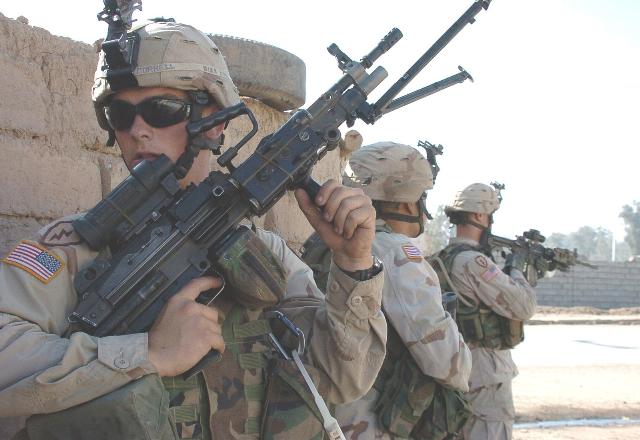A bullet resistant vest primer
We often hear about “bullet proof” vests. TV/movie good guys shot while wearing one immediately fall to the ground, breathless and momentarily incapacitated, even though the bullet did not penetrate the vest. Dramatic, but mostly nonsensical.
There is no such thing as a “bullet proof” vest, merely vests designed to be bullet resistant, capable, depending on design, of stopping some, but not all, cartridges. The vests worn by these US troops, for example, are commonly rated to stop the usual rifle caliber cartridges of known enemies. However, they are heavy, hot and somewhat restrict movement.

Graphic: Pfc. Ty Correll provides rear security. Wikimedia Commons.org. Public Domain.
The kinds of vests that have become increasingly popular and inexpensive are designed only to stop common handgun and some shotgun cartridges. The National Institute of Justice sets standards for protection levels, levels II, II-A and II-A—the most common—predominating. They will not stop common rifle cartridges.
The three levels are relatively light and reasonably comfortable, but in summer heat are rather like wearing a plastic trashbag. That’s better than being otherwise ventilated, but they’re never entirely comfortable and after wearing one for several hours, a shower is more or less mandatory. They consist of a carrier—normally a cloth blend with Velcro closures for adjustment that hold the ballistic panels—and the panels, made of various levels of Kevlar and other ballistic fabrics. There are other vests made to protect specifically against stabbing/slashing attacks, but we’ll stick with common, ballistic vests.
Police officers have long worn vests, initially under uniform shirts to conceal them. However, pretty much everyone, and certainly criminals, know officers wear vests, and police agencies are now wearing vests that feature options for carrying various equipment over shirts. They’re more comfortable and convenient, particularly considering the amount of gear officers have to carry.
As one might imagine, politicians don’t like citizens keeping and bearing arms, and don’t like citizens wearing protection against increasingly distrusted federal police. They also don’t like citizens being protected against criminals in any way, but thus far, that holds true primarily in blue cities and states. A California representative—surprise!—wants to ban civilian ownership or wearing of bullet resistant vests:
A California congressman wants to ban everyday Americans from owning high-performance body armor.
Rep. Mike Honda, a Democrat, tells U.S. News law enforcement officers need an edge over criminals and rampaging madmen, whom he says can “wreck havoc with impunity” wearing the gear.
Honda’s “Responsible Body Armor Possession Act,” introduced July 31, would prohibit civilians from buying or owning armor – including vests, shields, helmets and other items – rated Type III or higher on the National Institute of Justice’s penetration resistance scale.
“We don't need to have individuals owning these things and going around with a higher degree of protection against law enforcement,” he says. “I’ve seen a trend that there’s more and more body armor being used, and they’re usually used by folks who want to do harm.”
Honda would ban vests capable of stopping common handgun and shotgun ammunition, and the heavier, tactical vests Police SWAT teams and our military wear. Levels II and III are the most common civilian and police body armor. One might reasonably ask why, if such vests are good enough for the police and military—public servants--they aren’t good enough for the public? No government that has ever disarmed the public, or deprived them of body armor, did it to increase individual liberty.
What’s being shot while wearing a vest like? Decades ago Chuck Taylor, then the editor of SWAT Magazine, was shot at very close range while wearing a SWAT level vest with metal trauma plates swapped out after each shot, to gauge the felt energy transmitted to the wearer. Common handgun rounds like the 9mm or .45ACP transmitted little felt energy and no injuries. The same was true of even the venerable .308. The round that transmitted the greatest perceived effect, described as akin to being hit with a baseball bat, with a .44 Magnum handgun cartridge. Obviously, a rifle cartridge like the .308 is far more powerful than any handgun cartridge, yet the .44 magnum had more perceived energy. No cartridge knocked him down or incapacitated him.
Being shot while wearing a level II or III vest will likely produce bruising, but probably little else. Many police officers shot in the heat and speed of battle don’t realize it until afterward when they find holes in their carriers and flattened bullets stuck in their armor.
How much are vests? Expect to spend a minimum of $300, and many companies make and market them. These days going armed is wise. Going armored when one is expecting trouble, wiser.
Mike McDaniel is a USAF veteran, classically trained musician, Japanese and European fencer, life-long athlete, firearm instructor, retired police officer and high school and college English teacher. He is a published author and blogger. His home blog is Stately McDaniel Manor.





